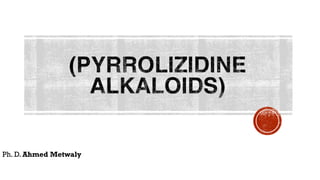
Pyrrolizidine alkaloids (2018)
- 1. Ph. D. Ahmed Metwaly
- 3. The bicyclic pyrrolizidine nucleus is formed by the utilization of two moles of ornithine and this pathway is accomplished via the intermediate putrescine.
- 4. ▪ In nature, the pyrrolizidine alkaloids have a relatively broad stretch of distribution, but are specifically present in certain genera of the Leguminosae/Fabaceae (e.g., Crotalaria); the Compositae/Asteraceae (e.g., Senecio); and the Boraginaceae (e.g., Heliotropium, Symphytum, and Cynoglossum). ▪ The alkaloids present often in the seeds and flowering parts of the plant. ▪ Broadly speaking the pyrrolizidine bases do not occur in their free form, but are mostly found as esters with rare mono-or di-basic acids, the necic acids. ▪ Necic acids are mono- or dicarboxylic acids with branched carbon chains composed of 5-10 carbon atoms. ▪ The two important alkaloids of this category are, namely: ▪ Retronecine and Senecionine, which shall be discussed :
- 5. ▪ PAs are toxins exclusively biosynthesised by plants.They are typical plant secondary metabolites against herbivores. It has been estimated that approximately 6000 plant species world wide, representing 3 % of all flowering plants, may contain pyrrolizidine alkaloids. ▪ To date, approximately 600 different PAs are known.
- 6. ▪ A double bond at the C-1 and C-2 positions determines the hepatotoxicity of these alkaloids. In the absence of a double bond, no metabolic activation to the pyrrole nucleus, which induces the hepatotoxic or genotoxic actions, was observed. ▪ Pyrrolizidine alkaloids often occur as N-oxides (except for the otonecine) ▪ The oral intake of unsaturated PAs is limited to 0.35 μg/day up to 14 days for adults, and for the representatives of sensitive groups, e.g., children: 0.007 μg PAs/kg body weight (bw), to prevent the occurrence of side effects. ▪ The animal toxicity of these compounds is also significant and led to a thorough examination of their influence on grazing in animals.The effects of a single administration of PAs containing plants may progress to advanced liver disease, cirrhosis, or tumors in animals. Pigs and poultry are much more susceptible than cattle and horses, whereas sheep and goats are found to be relatively resistant to pyrrolizidine alkaloids evoked toxicity. ▪ Contamination of foods or food supplements with PAs is commonly reported due to the structural variety of these alkaloids.
- 8. ▪ In general, PAs show either no or low acute toxicity; but they can undergo a 3-step metabolic toxication process leading to alkylating agents.This process takes place in the human or animal liver and this organ is therefore the first target organ for the intoxication. ▪ PAs can show mutagenic, genotoxic, cancerogenic and fetotoxic potential
- 9. ▪ Although these alkaloids have at present no great medicinal significance they are important in that they constitute the poisonous hepatotoxic constituents of plants of the genus Senecio (Compositae), well-known for their toxicity to livestock. Some of the alkaloids also show carcinogenic and mutagenic properties and have caused concern in that they occur in small quantities in some herbal products such as comfrey (Boraginaceae) and coltsfoot (Compositae). These alkaloids are known to have an ecological role in some species of butterfly affording protection to some and converting to female flight arrestants in others. The hepatotoxic properties are believed to arise by breakdown of the alkaloids in the liver to strongly alkylating pyrrole esters. Pyrrolizidine alkaloids were found to contaminate such human food sources as wheat, milk, and honey
- 13. ▪ Retronecine The most common base portion of the pyrrolizidine alkaloids is retronecine. ▪ The ‘Necine’ bases are 1-methylpyrrolizidines of different stereochemical configurations and degree of hydroxylation. ▪ Biological Source It is obtained from the herbs of Heliotropium europaeum L. (Boraginaceae)
- 14. (1R-trans)-2, 3, 5, 7, a-Tetrahydro-1-hydroxy-1 H-pyrrolizine-7-methanol; (C8H13NO2).
- 15. ▪ Characteristic Features ▪ 1. It is obtained as crystals from acetone having mp 119-120°C. ▪ Uses ▪ 1.The plant is used for cancer and is popularly known as “Herbe Du Cancer” in Europe. ▪ 2. It is also used for snakebite and scorpion stings.
- 16. ▪ Synonym Aureine; ▪ Biological Source The hepatotoxic alkaloid is obtained from the whole plant of Senecio vulgaris L. (Compositae); ▪ weed of Senecio aureus L. (Asteraceae) ▪ and preblooming plant of Tussilago farfara L. (Asteraceae)
- 18. ▪ Characteristic Features ▪ It is obtained as plates having mp 236°C and a bitter taste. ▪ It is practically insoluble in water; freely soluble in chloroform; and slightly soluble in ether and ethanol. ▪ Uses ▪ 1. It is used as an excellent drug to control pulmonary hemorrhage.
- 20. ▪ Indicine N-oxide isolated from Heliotropium indicum ▪ Indicine N-oxide shows an antitumor activity. In early clinical studies the possibility of using it for the treatment of leukemia and tumors was discussed. ▪ Since the compound exhibited promising cytotoxic activity, it underwent preclinical and clinical trials in the past for the treatment of acute leukemia of childhood ▪ Cytotoxicity of INO is due its DNA damaging activities and its inhibitory effects on the assembly of tubulin into microtubules ▪ But severe toxic side-effects showed that a therapy with indicine-N-oxide was not justified
- 22. Ph. D. Ahmed M. Metwaly Assistant professor, Pharmacognosy department, Faculty of Pharmacy, Al-Azhar University. ametwaly@azhar.edu.eg
